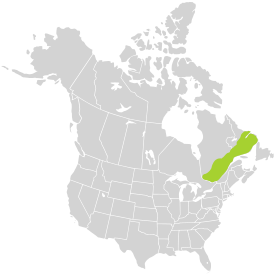| Laurentian Mountains | |
|---|---|
 Jacques-Cartier Massif, as seen from Jacques-Cartier National Park | |
| Highest point | |
| Peak | Mont Raoul Blanchard |
| Elevation | 1,166 m (3,825 ft) |
| Coordinates | 47°19′N 70°50′W / 47.317°N 70.833°W |
| Dimensions | |
| Length | 1,448 km (900 mi) |
| Geography | |
| Country | Canada |
| Province | |
| Range coordinates | 50°28′49.17″N 68°20′11.13″W / 50.4803250°N 68.3364250°W |
| Geology | |
| Orogeny | Grenville orogeny |
| Rock age | Precambrian |
| Rock types | |
The Laurentian Mountains, also known as the Laurentians or Laurentides, are a mountain range in Canada. The range is 1,448 km (900 mi) long and ranges in height from 500 m (1,640 ft) with peaks over 1,000 m (3,280 ft). The Laurentian Mountains extend across Labrador and Quebec within the Laurentian Upland, which contains foothills in northeastern Ontario. The range is located near the rivers of Ottawa, St. Lawrence, and Saguenay. The Laurentian Mountains primarily stretch across multiple regions in Quebec, with geologic formations such as the Jacques-Cartier Massif located within the range.
The Laurentians Mountains are one of the oldest mountain ranges on earth. The range formed around one billion years ago during the Grenville orogeny, in which the Grenville Province formed, a subdivision of the Canadian Shield. During that time, Laurentia, the geologic core of the Canadian Shield, collided with other continents and formed Precambrian rocks which extend across the range. The mountain range is located around other related geographic features, such as the Monteregian Hills and the Adirondack Mountains.
The Laurentian Mountains are home to vast extents of boreal ecosystems and mixed forests. The southern areas of the range are dominated by black spruce and balsam fir, with areas of white birch. The range is home to various wildlife species. The Laurentian Mountains are an important part of the economy of Quebec, as they have been historically been used for forestry and provide access to tourism and outdoor recreation for people in the region.
